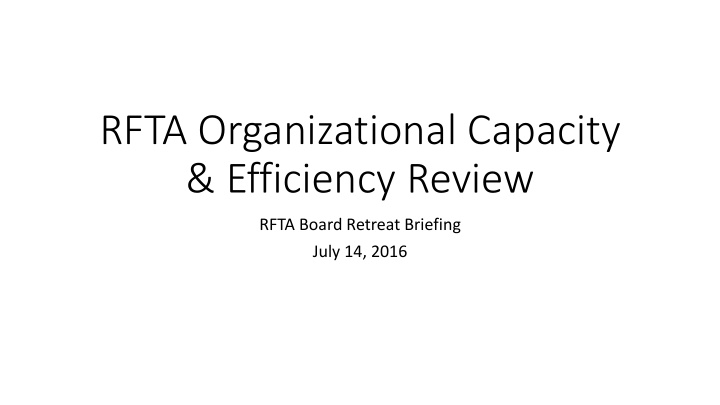



RFTA Organizational Capacity & Efficiency Review RFTA Board Retreat Briefing July 14, 2016
Overview • Efficiency review considers existing conditions and RFTA’s strengths and weaknesses in terms of: • Services provided • Organizational structure • Funding picture • Efficiency review addresses RFTA’s future sustainability as an organization in terms of: • Challenges • Opportunities • Recommendations
What is RFTA? • Unique and highly efficient agency • Accomplished 4 major service expansions since 1983 • Lean organization is highly cost effective • RFTA faces challenges and opportunities, both internally and externally • RFTA vehicle fleet is in overall good condition but needs approximately 92 replacement buses in next 10 years • Additional capital needs include expansion of transit services and facilities, including along the I-70 corridor
Challenges • Broad mix of transit services, fleet, O&M facilities, pedestrian crossings, park-n- rides, employee housing, recreational trail • Service area is geographically vast and demographically diverse • Five unique seasons with different sets of transit demands • Growing population/employment and demand for transit services • Over the past six years (2010-2015): • Ridership increased 25% • O&M cost per passenger increased 16% • Funding needs for growing O&M costs plus fleet replacement, O&M facilities, park-n-rides, employee housing, and other capital costs
Overall Trends Noted RFTA 2015 Performance Measures RFTA 2010-2015 Trends 97 37% 40% 100 35% 90 25% 30% 80 70 25% 16% 60 20% 50 15% 6% 40 18 10% 30 $5.96 5% 20 0% 10 Total Total Miles Average O&M Average O&M 0 Passengers Cost per Cost per Mile Passengers per Rides per capita O&M Cost per Passenger Hour served Passenger 400% better 7% better 25% better RFTA meets or exceeds all typical performance measures compared with peer agencies, while minimizing costs, in spite of long distances traveled and miles of commuter service provided
Initial Observation Ridership Data Recording
Initial Observation RFTA has Enterprise Asset Management (EAM) software to help manage assets.
Draft Recommendations • A Data Analyst position could be created within RFTA. • Data Analyst can implement the right software to streamline Ridership and Route Mileage Data acquisition. • RFTA is equipped with several high capability software assets, that could be better utilized. For example, RFTA could better integrate with Google Transit, a planning tool that combines the latest agency data with Google Maps. • Provide training and support for RFTA staff to utilize EAM data management software to its fullest potential to benefit the overall organization.
Initial Observation BRT Average operating speed
BRT Service Plan Issues • Current BRT Service plan based on requirements of FTA Very Small Starts grant • 3 Years of Operation as of September 2016 Draft Recommendation • Optimize BRT service plan
Initial Observation Recruitment incentives attract good, long term employees to RFTA.
Draft Recommendation • RFTA to explore opportunities to use Public-Private Partnerships (P3) to implement sustainable housing programs. • Opportunity to support employees at RFTA by offering additional affordable housing. • This would provide employees with the ability to establish financial stability in the region. • RFTA’s ability to offer housing is a strong recruitment incentive for attracting employees.
Initial Observations • Normalized O&M costs have increased at a rate that outpaces fares paid per passenger. • O&M cost per passenger increasing by 16% from 2010 to 2015 • Fare paid per passenger decreasing by 17% over that same period.
Draft Recommendation Identify sources of additional funding to offset increasing O&M costs.
Next Steps • Parsons team submitted Final Draft Report on July 8, 2016 for RFTA review • RFTA staff will complete reviews of final draft.
Recommend
More recommend